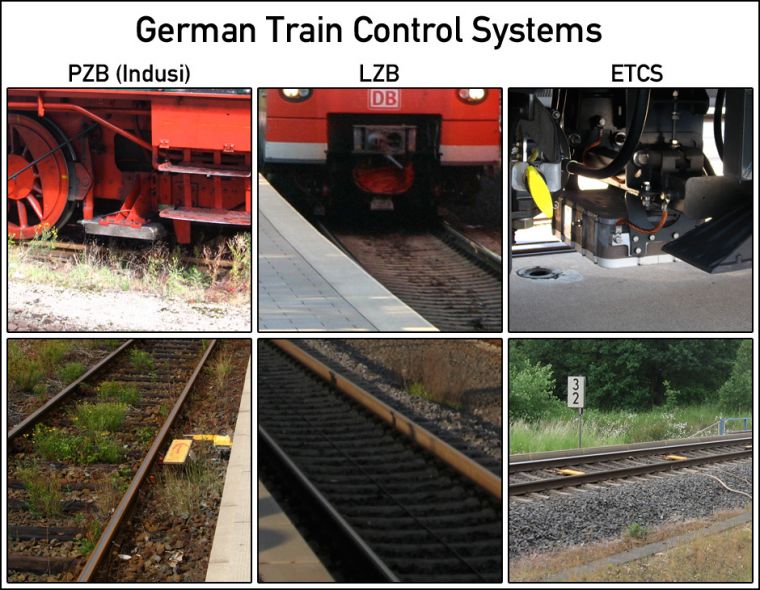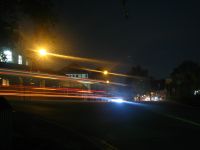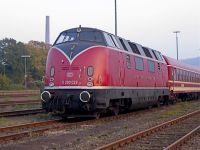German Train Control Systems

Posted: 6 October 2008

This work is licensed under a Creative Commons Germany license.
Notes
So if I got this right, a bill was passed in the US which finally makes some sort of train control mandatory (to be precise positive train control, the difference apparently being that trains will already be stopped before a red signal), something that in my opinion would have been a good idea fifty years ago already. To celebrate this occasion, take a look at the three systems in use in Germany. By the way, this proves that the AAR’s (Association of American Railroads) claim that PTC isn’t off-the-shelf-technology or not ready yet is a clear and obvious lie, so I’m kind of wondering why people let them get away with it. Sure, american trains are heavier, but I don’t believe that this requires more than simply changing a few configuration variables.
Train control systems vary, but the idea is, in the end, that a train that does something dangerous, in particular running over a red signal, is stopped.
The oldest system for that is the Punktförmige Zugbeeinflussung (discrete train control), also known as PZB or as Induktive Zugbeeinflussung (inductive train control) Indusi. Basically all german railroad lines (except some very low-traffic ones) are equipped with it. The trackside part is a coil, hidden in a metal box. This is always placed to the right of the track in direction of travel, as the (non-standard) arrow in Goslar station shows so nicely. The coil can be shorted, which makes the entire system active. The locomotive-side part, here of steam engine “Braunschweig”, has another coil in which electricity oscillates at a certain frequency. A short-circuited track coil will resonate if the frequency is right, which the train circuits will detect. Indusi will bring a train running over a red signal to an immediate halt. It can also check against trains starting against a red signal to a degree, and in later versions makes sure that a train brakes properly when heading towards a red signal. With a hack, it can also check whether a train is too fast. As the name implies, it can only do all of this at certain points in the line. The track-side circuitry actually does not require any electricity at all, a significant advantage in the day and age of semaphores.
The second system is the Linienzugbeeinflussung (continous train control) LZB. The track-side part here is a wire which runs the entire length of the line, as seen in Horrem, or actually two wires: One in the middle, one near the base of one rail. They cross each other at regular intervals. The necessary antenna is damn near impossible to take a picture of, except at trains of class 425 (and co), whose designer apparently thought that snow-plows were for the people who wave back at the Teletubbies. It’s the box below the coupling (notice that the red thing is just a cover for the coupling). The cable transmits a signal which gets picked up by the antenna. Thanks to the cable crossings, the train can find it’s position on the track very exactly. It shows the engineer a distance to a (more or less arbitrary) point and the speed he has to have then. If the engineer does not brake sufficiently, the system will intervene. This can, in fact, be used for automatic operations (with a driver still watching over the train), although the system does not know about scheduled passenger stops. It also means that you can move away from the old blocks, and have trains run in absolute braking distance. It also replaces trackside signals completely. LZB is required for speeds larger than 160 kph (100 mph), although it’s also used on a number of lower-speed lines to increase capacity. In fact, the class 425 shown above can’t even reach 160 kph to begin with.
LZB is, as far as we know, everything you could ever want from your train control system. The problem is that it first requires a lot of wires, and second and more importantly, it’s unique to Germany. Every country in europe has it’s own train control system, so that you physically can’t put all the coils, magnets, antennas, transmitters and brushes on the same truck. To solve this, a new system was developed, called European Train Control System or ETCS.
ETCS has two track-side components: The Eurobalise, a yellow thing mounted between the rails, here in the Siemens Testcenter Wildenberg Wegrath, and the Euroloop (of which I don’t have a picture), which is just a wire and allows an LZB-like continuous over a certain stretch of track. A balise can either transmit a fixed set of information, or one that comes from an external source, and like PZB it does not require any external power source for this. What’s odd is that it’s symmetrically placed, so you have to have two if you want some information to be only available in one direction, so the train knows which direction it is traveling in.
Finding the trainside component of ETCS requires you to basically crawl into the bogie of a locomotive, which I could safely do with the SNCB class 18 at Innotrans. Don’t try this at home, kids, since you most likely don’t have a locomotive at home.
ETCS comes in three levels: Level one transmits basically the signal information using the variable-data kind of Eurobalises. It still requires trackside signals to tell a train that has stopped in front of a (possibly virtual) red signal that it can move again, although in theory you can use an Euroloop to transmit the same information (using an Eurobalise would require you to stop the train within a few centimetres (a few less inches)). Level two uses fixed-data Eurobalises to tell the train, periodically, exactly where it is (in between, the train just uses the odometer to find out). All other information about what the train is allowed is transmitted using GSM. Level three is the same as level two, only where level two still has fixed virtual blocks, level three allows the trains to drive within braking distance of one another. The latter two are, as I understand it, quite similar to the american PTC approaches, only that they use GPS for localizing.
ETCS isn’t installed commonly yet or even fully finished, but all european countries (possibly except the UK, I’ve no real idea what they do) have committed to using it some time in the future. Just to confuse you, the S-Bahn Berlin is experimenting with a system that is based on ETCS components, but not actually compatible, and tilting trains in Germany also use a system based on ETCS but incompatible which tells a train with active tilting technology that it can drive faster through some curves than the PZB-based system allowes.

 Deutsche Version
Deutsche Version Entire Gallery
Entire Gallery

 Next Picture
Next Picture
 Previous Picture
Previous Picture